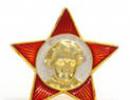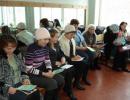Cognition. Cognition Summary of classes in mathematics
Topic: Introduction to the number and number 0.
Target : enter the number 0 as a characteristic of an empty set and the starting point on a numerical segment, teach how to write the number 0;
Tasks:
Subject: familiarization with the number and number 0; comparison of numbers based on the order of the numbers in the count. The number 0, its receipt and designation. Counting skill within 10.
Communicative: take into account different opinions and strive to coordinate different positions in cooperation.
cognitive : general educational - identifying the properties of zero using visual models, applying these properties when comparing, adding and subtracting numbers; writing the number 0, correlating the number and the number 0, writing the property of zero in alphabetical form; count within 10; logical - the establishment of cause-and-effect relationships; comparison of groups of objects.
Regulatory: determine the purpose of the activity in the lesson with the help of the teacher and independently; distinguish between the method and the result of an action.
Personal: have a desire to learn; recognize the need for self-improvement.
During the classes
1. Organizational moment.
Arms? On the spot!
Legs? On the spot!
Elbows? At the edge!
Back? Straight!
Let's prepare our ears - listen carefully,
Let's prepare our eyes - let's be observant.
The motto of our lesson: "You know, speak, if you don't know, listen." How do you understand its meaning?
2. Actualization of knowledge.
How do we start our lesson?
Why repeat what we already know?
Verbal counting.
Let's remember what we already know and can do?
1.- What task can be done with expressions?
3+1= 4
7-2= 5
6-3= 3
9+1= 10
2+1= 3
–What can be done with the answers in the examples (compare, name neighbors, next, previous)
2. Task -1 the student performs at the blackboard, makes up the numbers in ascending order.(examination)
3. Game "Call - do not yawn!"
1. U. What number is called when counting after the number 8?
U. Before the number 7?
U. Between the numbers 4 and 6?
U. What number is 1 more than 7?
U. Increase 6 by 1.
U. Increase 8 by 1.
U. Reduce 6 by 2.
U. Reduce 5 by 1.
4. Work in pairs. (We follow the rules of working in pairs)
Formulation of the problem
U. The carrots are laid out on plates, you need to connect the numbers with the number of carrots.

ExaminationEach student has a template on their desk that they work with. The job is then checked.
U. Can we do it here?
D. Not
U. Why?
D. So this plate is empty, and there is no suitable number.
- What do you think the number should be? Who signed it?
What is the topic of the lesson?
3. Message of the topic and purpose of the lesson.
Today in the lesson we will talk about the number and the number 0.
Purpose: to learn how to write this figure.
And find out her place in numerical series.
4. Work on new topic
How can you get any natural number?
As a result of determining the quantity, order.
As a result of measuring quantities.
As a result of arithmetic operations.
Study.
Investigate whether the number 0 can be obtained in the same way.
You have a research sheet.
Draw 0 crocodiles. 0 bears, 0 elephants, 0 laps...
Draw a line with a length of 0 cm.
Pour 0 liters of water.
How many grandparents are in your class?
How many talking dogs do you know?
How many cats you know know how to embroider?
Think of similar questions. What will they be about?
What conclusion did they come to?
0 is a non-negative integer.not natural.It can only be obtained as a result of actions.Unambiguous, comes before 1, non-natural)
Where is it on the number line?
Here he is, look at him. It is called zero or zero and denotes "nothing" by it. It would seem that they are talking about him: zero and zero are empty. This means, someone will think, a completely trifling figure, without which it is easy to do. But that's not the case at all. If you figure it out, it turns out that zero is a very important person. How to write 10 if you don't put this magic circle after 1? It will turn out 1, and not at all what we wanted. Name some other numbers in which zero plays a very important role.
D. 20, 30, 100, etc.
U. In Hungary, in Budapest, Friday is set to zero. No other figure has received such honors. Here he is, look at him(slide number 11) .
The people say : - Who knows what these expressions mean?
To start from scratch (colloquial) - from scratch, when there is nothing else.
Zero attention (colloquial) - no attention.
And now we will check how much attention you have.
2. Primary fastening.
1. Work with the textbook p.70
U. How many leaves were on the branch?
D. 3.
U. What happened?
D. One leaf fell.
U. How many leaves are left?
D. 2.
U. How was it recorded?
D. 3 – 1 = 2.
U. Has the number of leaves increased or decreased?
D. Decreased.
U. How to write it down?
D. 2 < 3.
U. How many leaves were left when the last leaf fell?
D. Not at all.
U. How was it recorded?
D. 1 – 1 = 0.
U. Which is less: 0 or 1?
D. 0 < 1.
U. Where will the number 0 take its place in the series of numbers?
D. Before 1.
U. Why?
D. Because 0 is less than 1.
U. How many berries were on the branch?
D. 5.
U. How much has it become?
D. 0.
U. How was it recorded?
D. 5 – 5 = 0.
Similar work carried out with clarity (3 - 3 = 0, 6 - 6 = 0).
U. What did you notice? How can you get 0?
D. If you subtract the same number from a number, you get 0.
Give your examples a-a=0
2. Repetition. p.71.
3. Work in a notebook. What does the number 0 look like?
Let's learn how to write the number zero. Printed straight. Written numeral numeral with slope. Consider a sample. (slide 13)
Open your notebookspage 26 .
Write the number in your notebook. Put dots under the most beautiful numbers.
Let's find the place of zero in a series of numbers. 0 less than any natural number. Write in your notebook.
Take a pencil. Draw lines to match the drawing.
Interesting Facts about number 0
The Indians called zero - sunya, which meant "empty", and at the beginning they denoted it with a dot. AT different countries this figure was also called onom, because it looked like the letter o, gradually the circle began to mean nothing, and the number 0 was born one and a half thousand years ago in India. Zero was attached to the numbers. And how many numbers are there? (ten).
VIII. Summary of the lesson.
What do we now know about the number 0?
So zero means nothing?
Guys, will the ability to write the number 0 come in handy in life?
– What does the number 0 mean?
Reflection:
What did we have learning task? (get acquainted with the number and number 0)
Have we solved it?
Are you satisfied with your work?
And I liked the way you worked. You were active, you tried. Thank you for the lesson. They patted themselves.
Think and tell me, in life, where have you had to meet with 0?
Tell the diagram:
I know
remembered
About : smog
I know how the number 0 is written and I know what the number zero means
I remember where the number 0 stands in a series of numbers, how it is obtained.
I was able to correctly write the number 0 and made the correct equalities and inequalities.
Tasks on cards:
Compare:
0 … 1 6 … 0 0 … 4
0 … 5 2 … 0 3 … 0
Make a conclusion:
0 (greater than, less than, equal to) any natural number.
Mark place 0 on the number line.
1 2 3 4 5 6 7 8 9
Abstract of a lesson in mathematics
Introduction to 0.
Target: Introduce the number and number 0.
Tasks.
Educational: The formation of the number 0, its place in the number series.
Developing: The development of the logic of thinking, mathematical ingenuity.
Educational: Cultivate a love of mathematics.
Equipment: planar characters of the fairy tale "Gingerbread Man"; number 0. Handout: on the tables of children are large pumpkin seeds, beans, colored sticks.
Course progress.
Didactic game"What changed?"
Purpose of the game: develop voluntary attention and short-term memory; cultivate honesty.
Material: a few small toys or other items familiar to children.
Game progress: several small toys or other objects familiar to children are placed on the table. A leader is selected who invites the players to remember what and in what order is on the table. Then the facilitator invites the participants to turn away, and at this time he swaps several toys and invites the guys to guess what has changed on the table. For each correct answer, the presenter awards a chip. The one who collects the most chips wins.
- Guys, tell me, what is a fairy tale? (This is when, something magical).
- Would you like to get into a mathematical fairy tale? Then let's go on a journey.
Guys, come on, pick up binoculars (depict binoculars with your hands), what do you see? (An image of a kolobok appears on the board). (Kolobok ran away from his grandmother).
Let's take a look at the beginning of the story. (Children together with the teacher remember).
- ... Gingerbread man rolls, rolls, and the Hare meets him (the image of a hare appears on the board).
Kolobok, Kolobok, I'll eat you!
Don't eat me Bunny, better let me solve problems.
Let's help Kolobok solve difficult problems, otherwise the Hare will eat him! (Children solve problems: a card from the card index "Feast of the Number", "Think, count, guess!" Tasks for ingenuity -0-:
There is an oak tree in the field. Oak has 3 branches. Each branch has 3 apples. How many apples are there?
(Not at all).
10 pears grew on a pear, and 2 less on a willow. How many pears grew on the willow?
(Not at all, since pears do not grow on willows).
The hare released Kolobok.
Did you guys guess what number we're going to meet today?
That's right, zero!
Why are we in this fairy tale?
What do you think? (Kolobok looks like 0).
What else does the number 0 look like? (card “what does the number look like?”).
Do not eat me, Wolf, it is better to ask difficult questions and interesting tasks!
(Card. Tasks in verses -0-). Problem about geese.
Seven angry geese
Seven desperate friends
They walk and roam: "Ha-ha-ha!"
Then the hostess called them: -
Do you want to eat? - Yes Yes Yes!
And the whole gang went
Seven angry geese.
Seven geese have gone to feed,
How many birds are left?
(Not at all).
During the task, children lay out pumpkin seeds and beans on their table. Show the answer, put the number 0 from the sticks. Let's show in the air how to write the number 0 correctly.
And now print this number with your finger on each other's palm, now on each other's backs.
You and Kolobok coped with the task. The wolf released the bun.
Kolobok, Kolobok, I'll eat you!
Don't eat me, Bear, it's better to give the task to me and the children. (Card. Tasks in verses -0- ... Egorka was lucky again ..., Badger - ...)
Egorka was lucky again,
Sitting by the river is not in vain.
Two crucians in a bucket
And four minnows.
But look - by the bucket
There was a sly cat...
How many fish home Yegorka
Will it bring to our ears?
(Not at all)
Badger Grandmother
She baked pancakes.
Treated two grandchildren -
Two pugnacious badgers.
And the grandchildren did not eat,
With a roar, saucers knock.
Well, how many badgers
Waiting for supplements and silent?
(No one waits in silence, but two wait with a roar)
Children solve problems.
Released Bear Kolobok.
Rolls, rolls, Kolobok, and the Fox meets him.
Kolobok, Kolobok, I'll eat you!
Don't eat me, Lisa, tell the guys what to do so that you don't eat me.
The fox invites the children to open the recipes and complete the tasks. Independent work children. The fox releases the bun.
Analysis, the result of the lesson:
Guys, if the Fox ate Kolobok, then what would be left of him? (nothing, zero).
What number are we talking about today?
What does this number look like?
If you liked the activity, then show the thumb up, and if you were bored, then show the thumb down.
Target: To create conditions for the formation of positive motivation for learning activities among first-graders.
Tasks:
Subject: familiarization with the number and number 0; comparison of numbers based on the order of the numbers in the count. The number 0, its receipt and designation. Counting skill within 10.
Communicative: take into account different opinions and strive to coordinate different positions in cooperation.
Cognitive: general educational - identifying the properties of zero using visual models, applying these properties when comparing, adding and subtracting numbers; writing the number 0, correlating the number and the number 0, writing the property of zero in alphabetical form; count within 10; logical - the establishment of cause-and-effect relationships; comparison of groups of objects.
Regulatory: determine the purpose of the activity in the lesson with the help of a teacher and independently; distinguish between the method and the result of an action.
Personal: have a desire to learn; recognize the need for self-improvement.
Download:
Preview:
Topic: Acquaintance with the number and number 0.
Target: To create conditions for the formation of positive motivation for learning activities among first-graders.
Tasks:
Subject: familiarization with the number and number 0; comparison of numbers based on the order of the numbers in the count. The number 0, its receipt and designation. Counting skill within 10.
Communicative: take into account different opinions and strive to coordinate different positions in cooperation.
Cognitive: general educational - identifying the properties of zero using visual models, applying these properties when comparing, adding and subtracting numbers; writing the number 0, correlating the number and the number 0, writing the property of zero in alphabetical form; count within 10; logical - the establishment of cause-and-effect relationships; comparison of groups of objects.
Regulatory: determine the purpose of the activity in the lesson with the help of a teacher and independently; distinguish between the method and the result of an action.
Personal: have a desire to learn; recognize the need for self-improvement.
Material and technical equipment of the lesson:
General class work: an auditorium board with a magnetic surface, a table for writing numbers, subject pictures, cards with numbers; three squares: green, yellow, red - for reflection, a projector, a screen, a computer with at least 8 Flash-player installed, a multimedia presentation.
Pair work: cards with houses for the game "Let's populate the house."
The set goal of each stage
Lesson stages
During the classes
Children activities
Prepare students for work: provide an external favorable environment for work, psychologically set the guys up for joint activities.
1.Org. moment.
The bell rang loudly
The lesson starts.
Our ears are on top,
Eyes open wide -
We listen, we remember
We don't waste a minute!
Checking the readiness of children for the lesson. slide 1
Greeting guests. Posture check.
Provide at the very beginning of the lesson high level student involvement in learning activities. The development of attention and memory, preparation for a "life" account, where you often have to perform actions on numbers that are perceived by ear.
2. Oral account.
We start each math lesson with you with mental counting. What for? What does it give you? Maybe it's bad for health? (Answers of children.). slide 2
So, we do exercises for the mind. And in this you will be helped by your knowledge that you received in previous mathematics lessons.
a)- Count from 1 to 10 (1 row).
Count from 10 to 1 (2nd row).
Count from 4 to 9 (3rd row).
b ) Prepare fans of numbers and show only the answer.
The number following the number 8;
The number preceding the number 3;
Number 6 neighbors.
c) Problem solving Slide 3 The choice of action is a fan.
Sun-1 row
Four ripe pears
Swinging on a branch
Pavlusha took off two pears,
How many pears are left? (4-2=2) slide 4
Cloud-2 row
A rooster flew over the fence
I met two more there.
How many roosters have become? (1+2=3) slide 5
Chamomile-3 row
For a walk from the nursery
Ten kids came out.
Five of them sat on the grass
The rest are on the swing.
How many children sat on the swing? (10-5=5) slide 6
G)- The game "Let's populate the house" (pair work, low-performing students perform the task with the help of counting sticks). Slide 7
Examination.
Lead students to formulate the topic of the lesson (implementation of the idea of pedagogical cooperation).
On the basis of active speech-thinking activity, students participate in goal-setting. This approach creates a self-setting for students to achieve the goal of the lesson, stimulates fruitful learning activities.
3. Introduction to the topic of the lesson. Lesson goal setting.
I want to tell you about one boy. Listen to what happened to him.
Egorka was lucky again,
By the river he did not sit down in vain:
Two crucians in a bucket
And four minnows.
But look - at the bucket
A sly cat appeared
How many fish home Yegorka
Will it bring to our ears? Slide 8
It won’t bring anything, the cunning cat will eat everything.)
2. Determining the purpose of the lesson
What number can express the number of fish that Yegorka has left? (number 0)
How to say differently? (Nothing or zero).
Show the number of objects in the picture using a fan of numbers.
- In my opinion, we have not yet encountered the absence of objects in the lessons. How can we label it?
Who guessed what the topic of our lesson today is?
(Introduction to the number and number 0.) slide 9
And our friends will help us in this - Smeshariki
Formation of motivation for teaching and learning.
Implementation of the principle of activity.
4. Learning new material.
Textbook work.
Find a topic in a textbook and read it.
- Nyusha's task. Slide 10
How many pies are on the plate? (9.)
- They ate all the pies. How many pies are left on the plate? (Not one pie.)
Recording: 9 without 9 is. 9 - 9 = . slide 11
The teacher shows a card with the number 0.
- Look at what the number looks like, with which the number "zero" is written.
It is called zero or zero and denotes "nothing" by it. It would seem that there is nothing to talk about it: zero and zero are empty. This means, someone will think, a completely trifling figure, without which it is easy to do. Do you guys agree? No, it's not like that at all. If you figure it out, it turns out that zero is a very important person. How to write 10 if you don't put this magic circle after 1? It will turn out 1, and not at all what we wanted. Name some other numbers in which zero plays a very important role. (20, 30, 100, etc.)
In Hungary, in Budapest, Friday is set to zero. No other figure has received such honors. slide 12
What does the number 0 look like?
A number like the letter O
It's zero or nothing.
Round zero is so pretty
But it doesn't mean anything!
I can call it a ball
And if you want, we'll call it a hole,
And maybe a bagel
Almost round.
But whatever we call it
It's called zero!
2. Work in a notebook. Number letter 0
Explanation. The number 0 consists of one element - a large oval. We start writing just below the top of the upper right corner, round off, touching the top side of the cage, lead down, round off, touching the middle of the bottom side of the cage, round off and lead up to the beginning of the oval.
- We recall the landing rules when writing, the teacher shows a sample of writing zero.
3. Minute for the eyes. slide 13
4 . Krosh's task. Working with chips. Write numbers on the board. Slide 14
- Look at the pictures. How many ducks were there? (3.)
- How many ducks are there? (Zero.) How many ducks flew away? (3 ducks.) slide 15
Record: 3 - 3 = 0.
Kar-Karych's mission
How many birds were in the cage at first? (Zero.)
- How many birds are there? (2.) How many birds were planted? (2.) slide 16
Entry: 0 + 2 = 2. Slide 17
Task 5 (p. 51).
- Look at the picture of the ruler. Find and show the number 0.
– Compare each of the marked numbers with the number 0.
– How many steps from number 4 to number 0? (Four steps.)
– How many steps from number 0 to number 5? (Five steps.)
– How many steps from number 0 to number 8? (Eight steps.)
What is the place of zero in a series of numbers? (Comes before 1.)
Why? (Because zero is the smallest number.)
Fatigue Prevention
6. Fizminutka Slide 18
It's time to rest.
The first-graders stood up together,
And they all became animals.
Trampled like elephants
Turn around like foxes
They jumped like rabbits.
How the giraffes stretched
And they smiled at each other.
Waddling like mice
Everyone sat down to read books.
Tasks contribute to the formation of positive motivation for learning, cognitive activity, activate learning activities, create comfortable conditions for the development of communication skills, increase the effectiveness of the lesson.
7. Consolidation of the studied material.
It's time for questions. Slide 19
1. Task 5 (p. 51).
How many helicopters are in the picture? (3.) Ships? (4.) Cars? (6.)
- Come up with questions with the words “how much more”, “how much less”.
Question options:
a) How many more ships than helicopters? Slide 20
b) How many more cars than helicopters? slide 21
c) How many more cars than ships? slide 22
2. Work in a printed notebook
Getting and reading records of the form: 3 and 0 is 3.
Finding triangles in a shape. Slide 23-24
Establishing patterns in the recording of numbers and writing numbers in accordance with the established pattern.
Tracing (drawing) a line from a colored figure to a card with a number.
Comparison of the beginning of the pattern and its description (step-by-step control of the completed stage of work).
Continuation of the pattern.
Training in writing learned numbers.
8. The result of the lesson.
- What did you learn at the lesson?
What number did you learn to write?
Guys, will the ability to write the number 0 come in handy in life?
What does the number 0 mean?
Formation of self-esteem
9. Reflection.
There are three colored squares on the board. You have chips on your desks. Take and go to the desired square.
Green square - I did well, I was active in the lesson, I succeeded, I understood everything. Blue - I can work better, I didn’t succeed at everything in the lesson. Red - I had a hard time in class, I need help.
Sections: Primary School
Target:
- create conditions: to get acquainted with the number zero and the corresponding figure;
- for the development of analytical activity, observation, memorizing the image of numbers, geometric imagination.
Equipment:
- "Maths". Grade 1, part 1 (authors I. Arginskaya, E. Benenson, L. Itina);
- map “Country Mathematics”, cards with tasks.
During the classes
1. Organizational moment
Teacher: Guys, today we continue our journey through the Land of Mathematics. Do you agree?
Children: Yes.
Teacher: Name the places we have visited.
Children name the places, accompanying the display on the map.
Teacher: I propose to stop by the Sea of Numbers, how do you feel about this?
Children: Positively.
We agree.
2. Working with numbers
Teacher: What can you say?
Children: We see the numbers that we have studied. ( All possible answers are heard.)
Teacher: What job can you offer?
Children: You can compare these numbers. Write equalities and inequalities. Numbers can be written in ascending or descending order. Write a natural series of numbers.
(Work in pairs. Writing a natural series of numbers in a notebook).
Examination.
(Three different rows of numbers appear on the board in turn.)
Teacher: What can you say?
1, 2, 2, 3, 4, 5, 6, 7, 8, 9…
Children: This row is wrong, because the number 2 is repeated twice, and in the natural series, each next number is greater by one.
Teacher: What can you say?
1, 2, 3, 4, 5, 5, 6, 7, 8, 9…
Children: This row is wrong, because the number 5 is repeated twice, and in the natural series, each next number is one more.
Teacher: What can you say?
1, 2, 3, 4, 5, 6, 7, 8, 9…
Children: This row is correct, because each next number is one more.
(The first row is erased from the board first, because. found out that it is incorrect, then the second row is erased, only the third row remains on the board.)
Teacher: Remember why the first row was wrong.
Children: 2 was repeated twice.
Teacher: If you write 2 and 2 side by side, then how to read this number correctly?
Children: 22.
Teacher: What does this number mean.
Children: We study at school number 22.
Teacher:
Teacher: Remember why the second row was wrong.
Children: repeated twice.
Teacher: If you write 5 and 5 side by side, then how to read this number correctly?
Children: 55.
Teacher: What does this number mean.
Children: We have a holiday at school today and she turns 55 years old.
Teacher: I suggest writing this number five times in a notebook.
(Children write in notebooks and underline the most beautiful numbers.)
3. Physical Minute
Learning new material
What can you say about the picture on the board?
(There are 3 circles on the board with figures in them, the fourth appears after discussing three.)
Teacher: What tasks can you offer?
Teacher: How many figures are in the first circle?
Children: I count three. ( )
Teacher: How many figures are in the second circle?
Children: I count five.
Teacher: How many pieces are in the third circle?
Children: I count seven.
Teacher: What do these three circles have in common?
Children: I count geometric shapes.
Teacher: What are geometric shapes?
Children: I count circle, square, triangle.
Teacher: How many pieces are in the fourth circle?
Children: I consider none.
Teacher: How else can you say?
Children: I count zero figures in the fourth round.
Teacher: What do you think the task will be in today's lesson.
Children: I think to get acquainted with a number that means nothing, to learn how to write the number 0. ( Listen to the responses of several students.)
Working with the textbook 96 h.196 Work in pairs.

Teacher: Find out which animal is superfluous here and why?
Children: Excess protein, because. she has no wings. ( Listen to the responses of several students.)
Teacher: Is it possible to say that the squirrel has “0” wings? Why?
On the desk.
A number like the letter O
It's zero or nothing.
S Marshak
(Reading the poem in chorus, showing the printed and written number zero)
Teacher: What can you say about the printed and written number 0. ( Children's responses are heard.)
Teacher: I suggest trying to write down the number in a notebook yourself. And when we write down the numbers, where should we stop.
Children: At the Bay of Numbers. (Write a number in an air notebook, then in a notebook, underlining the most beautiful number.)

(Each child has a sheet with a picture.)
Teacher: What do you see?
Children: Picture. A picture with hidden numbers.
Teacher: What can you suggest?
Children: Find the numbers and write them down.
Teacher: I want to make an adjustment, write down each figure only once.
Children complete the task on their own.
2 3 5 8 4 1 9 6 7 0
Checking with writing on the board
0 1 2 3 4 5 6 7 8 9
Teacher: I suggest 0 to compare with other numbers. How to do it?
Children: You can write inequalities. ( They say verbally what inequalities can be written down, expressions appear on the board.)
| 0…1 0…2 0…3 |
0…4 0…5 0…6 |
0…7 0…8 0…9 |
Teacher: Offer a job.
Children: You need to put a comparison sign. ( Doing work in a notebook.)
Teacher: What can you conclude?
Children: The number zero is less than all the numbers we have studied.
Summing up the lesson.
Teacher: Guys tomorrow we will continue our acquaintance with mathematics. What new things did you discover today?
Children: We got acquainted with the number zero, the number 0.
We learned that zero is the smallest number in the number series.
- I liked working in pairs.
Teacher: Well done, thank you. Today you were attentive, worked together, helped each other.
- There is a sheet on your table, choose the bun that reflects your mood after the lesson, put any sign in the cloud.






